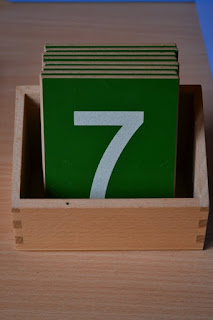A key element of a Montessori education is the "prepared environment" as we talked about in this post. A lot of time and forethought goes into the prepared environment. Because young children vary so much in their interests, skills, and confidence in themselves as learners, it only makes sense to design a learning environment that can easily accommodate those differences. And Montessori education does just that. Next September, I have lots of little newcomers and a new group of "old ones". Their abilities are all different of course and most of them will not be ready for the activities the "leaving group" was able to perform during the last 2 or 3 months of school. Soooo, I have started revewing my classroom. I spent another couple of hours working in the classroom today. My goals were to put away all the spring work that I had just left on the shelves since last May and prepare the maths corner.
I don't want to start the year with too many activities on the shelves to start for the simple reason that the chidren will not be able for most of it. In fact, our "newcomers" cannot really count up to 10 yet and most of their older peers are not able to recognise (nor write) numbers up to 10. So I put away our teens and tens boards, as well as our thousands/hundreds/tens units trays, our 100 board and our large number cards. Now, doing this is a little hard for me. It just seems like too little on the shelves. Anyway, this is what our Montessori mathematical area looks like now for next September:
Here is a closer look at all the activities/exercises that are on our shelves:
 |
| Hanging beads 1-9 |
 |
| Cut-out numerals and counters |
 |
Our traditional sandpaper numbers which will be used in connection with our counting plastic teddy bears. |
 |
| Spindle box |
 |
| Traditional wooden matching cards for the younger ones |
 |
| A picture matching game for the older kids |
 |
| Our geometrical shapes jigsaw (this is where sensorial area and maths area overlap!) |
 |
| Our counting caterpillar puzzle. It helps the children practice with their counting and numerals. |
 |
| A fun game encouraging early number skills |
Of course, as the children are developing their skills, I will introduce more Montessori materials on our shelves. Following the various themes we study during a year, I like to create mathematical activities to go with the studies, to keep the children's interest and enthusiasm going. But what I have shown you above is basically what we will start with in September. One thing I forgot to take in picture is our set of numerical rods which we use on a large mat beside the math shelving unit. The children will learn how to work with these rods as soon as September. Later on, I will introduce variations using the sandpaper numerals and then the cut-out numerals and counters. Keep in touch.




No comments:
Post a Comment
Please leave your comment right here. Thank you :)